The traditional craft of making paper flowers with naturally dyed hanji has barely been kept alive. Requiring a lot of time and money to produce, paper flowers have been largely replaced by natural flowers. Venerable Seokyong, initiated into the vanishing craft in the 1980s, has committed himself to recreating all the paper flowers that were once used to adorn Buddhist ceremonies.
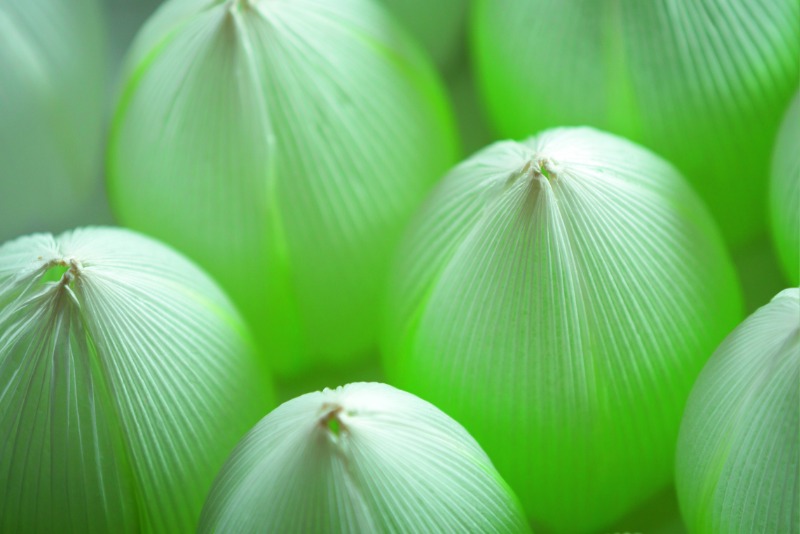
Lotus buds made with hanji, traditional mulberry paper, dyed with mugwort and textured with tiny pleats. To make traditional paper flowers, hanji is colored with natural dyes, moistened, and then textured with pleating, folding, rolling and pulling techniques. The most difficult is pleating, whereby tiny creases are made in the paper by pressing with a sharp knife.
Paper flowers, or jihwa, were extensively used in the past to decorate the sites of Buddhist and shamanic rites as well as royal court ceremonies. They were also important to rites held in commoners’ homes, such as weddings and funerals. Today, paper flowers have been largely replaced by fresh flowers that are grown all year round in greenhouses, but they can still be seen gracing grand ceremonies at Buddhist temples.
Flowers hold important symbolism in Buddhism. In a famous episode, Sakyamuni Buddha held up a lotus flower and Mahakasyapa responded with a smile as a sign that he understood the wisdom that the Buddha wanted to deliver. In many Buddhist scriptures, flowers stand for awakening. And in the Buddhist context, the Korean word jangeom (alamkaraka in Sanskrit), meaning “adornment” or “glory,” refers to embellishing a temple with flowers to worship the Buddha. After all, the craft of making paper flowers began in Buddhist temples as picking flowers was considered akin to taking a life.
One Buddhist monk has been carrying out the “magnificent and solemn” work for 40 years now, as a form of spiritual practice. Since his first exhibition in 2008, Venerable Seokyong has endeavored to make this traditional craft known to the wider public. His skills and efforts were officially recognized when the art of making paper flowers was designated as Intangible Cultural Heritage of Gyeonggi Province in 2017.
Natural Dyeing
Anyone seeing Venerable Seokyong’s paper flowers for the first time exclaims at the exquisite colors and ornate craftsmanship. It’s painstaking for human hands tosuch beauty, and the work requires unwavering perseverance. Starting with the preparation of materials, each flower is produced through a laborious process often stretching over a year, which is why the monk regards it as spiritual practice. The procedure includes dyeing traditional mulberry paper with natural dyes, folding the paper in tiny pleats to make petals, forming the petals into blossoms, then attaching stems made with bamboo strips.
The glue alone takes over six months to make. Whole wheat or glutinous rice is fermented in water, with the froth forming on the surface continuously skimmed away and the water changed over and over again for three to six months until all the grain substances are removed, leaving only starch. The entire process is repeated again to obtain a glue that prevents the paper from being eaten by moths.
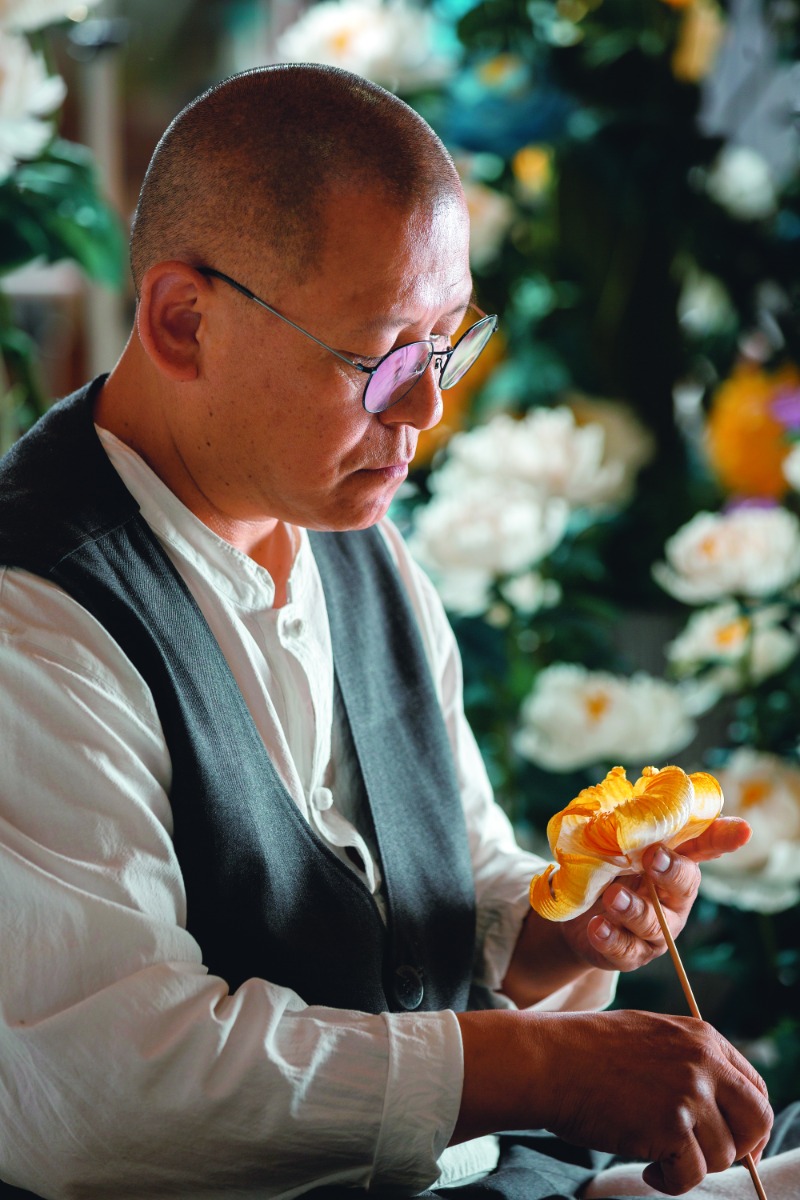
Venerable Seokyong makes a peony with pleated paper. Recognized for his skill and contribution to restoring the traditional craft over four decades, his craft was listed as Intangible Cultural Heritage of Gyeonggi Province in 2017.
Yeongsanjae, or the Rites of Vulture Peak, which was placed on UNESCO’s List of Intangible Cultural Heritage of Humanity in 2009, is usually held for three to five days. For these elaborate rites, Venerable Seokyong starts making flowers about a year and a half ahead of time. “Looking at the paper flowers set ablaze after each rite, I tell myself, ‘This is the end, I won’t do this anymore.’ But before I know it, I find myself preparing for the next rite,” he said.
Dyeing paper is the first real step. The monk uses plants collected and dried throughout the previous year. Blue is obtained from indigo, red from sappan wood, yellow from gardenias, green from mugwort, and purple from wild grapes and red-root gromwell. In addition, pale yellow is extracted from onions and bright red from safflowers. Indigo and safflower dyes are the most difficult to extract; the craft of indigo dyeing, which involves a very complicated fermentation procedure, has even been preserved as Korea’s state-designated Important Intangible Cultural Heritage. Whatever the dyestuff, the colors are acquired by repeatedly dipping the paper into the dye and drying it.
“We usually dye paper in the spring, although we can do it whenever necessary,” the monk said. “Paper dries perfectly in March and April.”
Moistening and Pleating
The most critical part of the entire process is controlling the moisture level of the paper before it’s folded into flower petals. The tiny pleats on the petals easily come undone when the paper is a little too dry. But when it is too damp, it’s hard to pleat the paper at all. The procedure that Venerable Seokyong calls “feeding moisture” may look simple but it can only be done with great sensitivity at the fingertips, developed through long years of experience. To treat the paper, a towel is soaked in water then wrung and spread out, and a piece of hanji is placed upon it. In this way, towels and sheets of paper are alternately ed in a stack, which is wrapped in plastic and stored in a warm room for a couple of hours. Then the paper is felt to check that it’s in the right condition for pleating. Flowers made with such carefully moistened hanji can last for decades without losing their shape.
“You can’t fold flowers when it rains. If it is unavoidable, the heating has to be turned on to lower the humidity. In summer, even using an electric fan can make the paper too dry. Hanji is extremely sensitive to humidity. The right state is when the paper feels slightly stiff,” Venerable Seokyong explained.
The flowers that he makes most frequently are those used to decorate the Buddhist altar: tree peonies, herbaceous peonies, chrysanthemums and lotus flowers. In secular terms, peonies symbolize wealth and prosperity, but in the sacred context, they are a symbol of the Buddha-mind, the heart of mercy and compassion. For this reason, the upper part of the altar is decorated with peonies, the middle part with chrysanthemums and mythical white lotus blossoms (pundarika in Sanskrit; darihwa in Korean), and the lower part with lotus flowers.
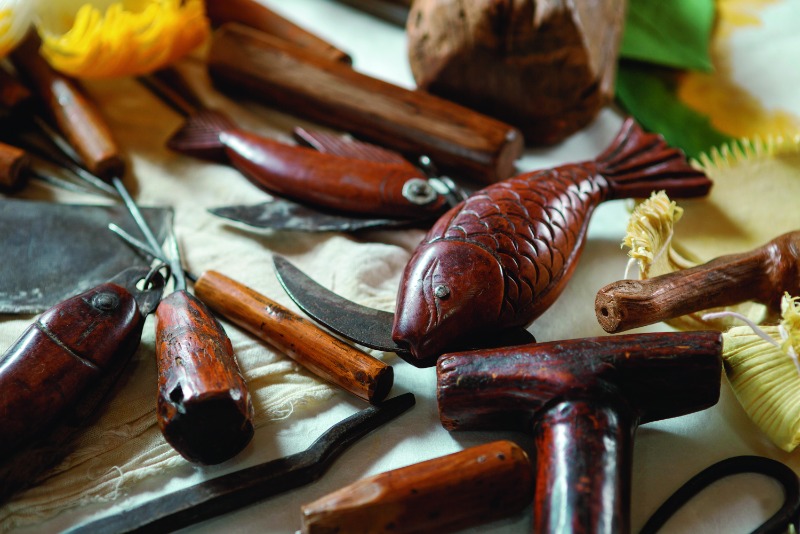
Various kinds of knives, awls and hammers are used to make paper flowers. The stems, made of bamboo or bush clover strips, are shaped with hammers and fishshaped knives, and chrysanthemum petals are fixed with an awl.
The first step in making the petals is to form fine winkles in the dyed paper by pleating, folding, rolling and pulling it. The most difficult technique is pleating, which involves pressing the thin paper with a sharp-edged knife. This work demands total concentration: with just a little too much pressure, the knife cuts through the paper.
“Once, a visitor at my exhibition asked me where the finely pleated paper was sold,” the monk recalled. “If I ever resorted to an easy solution, like using ready-made paper, it would be impossible to make the flowers look like real ones in nature. I feel pain in every joint of my fingers after working long hours pleating paper, but I repeat each and every step, thinking of it as spiritual practice.”
“I feel pain in every joint of my fingers after working long hours pleating paper, but I repeat each and every step, thinking of it as spiritual practice.”
Restoration of Tradition
If preserved properly, these paper flowers are said to last for over a thousand years, but few remain today. The paper blossoms are burned after each ceremony, so no artifacts exist to illuminate the entire history of the craft. There are also no descriptions of the procedures in historical literature. In the 1980s, Venerable Seokyong learned to make a few kinds of paper flowers in traditional methods that had been barely passed down at one temple. His teacher was Venerable Chungwang, who served at Guin Temple, the headquarters of the Cheontae Order of Korean Buddhism, located in Danyang, North Chungcheong Province.
After wards, Venerable Seokyong traveled around the country to learn from a handful of living artisans with the aim of restoring the original forms of traditional paper flowers. He simultaneously referred to paintings of paper flowers in historical s from the Goryeo and Joseon periods. Paper flowers are most frequently seen in Buddhist paintings, especially Nectar Ritual paintings dedicated to the souls in the netherworld for their rebirth in the Pure Land of Utmost Bliss. Based on paintings that depict paper flowers with relatively high accuracy, he has red many different species. As far as he knows, around 60 different species used to be made, of which he has red about 25. He believes his mission is to seek out and restore all the rest.
Of the various reference materials that the monk has collected for this purpose, a book about Korea published a century ago is especially valuable because of one black-and-white photograph.
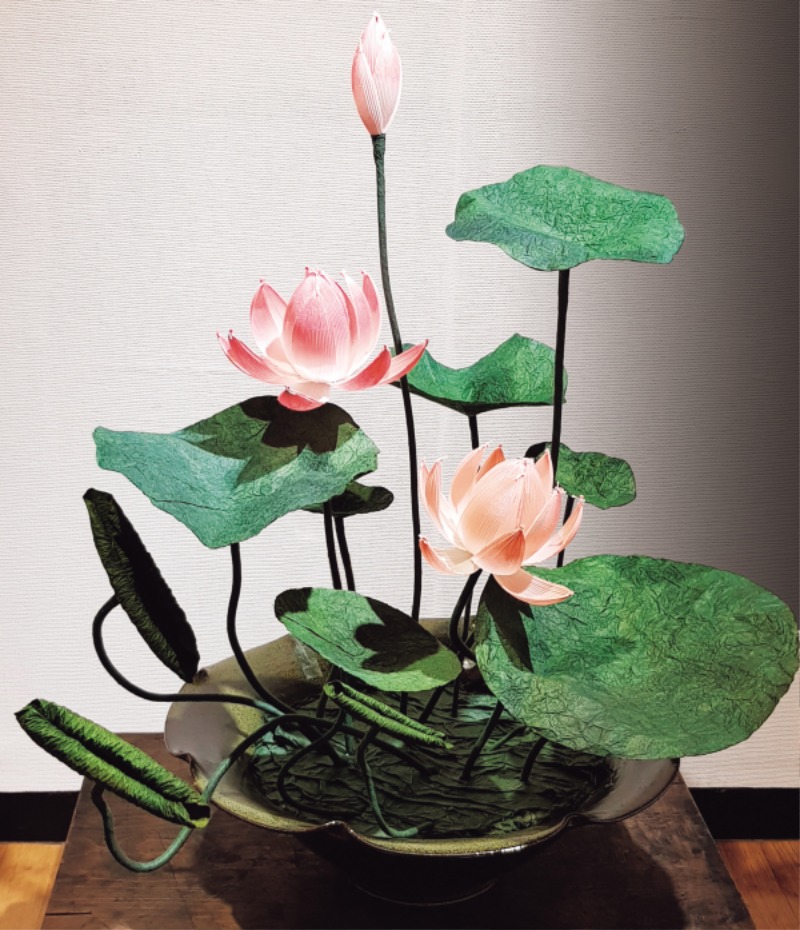
This piece expresses the Lotus Repository World of Vairocana, which represents the blissful land of the Buddha. For realistic depiction of lotus blossoms, Venerable Seokyong once observed the blooming and wilting of the flowers for four straight days.
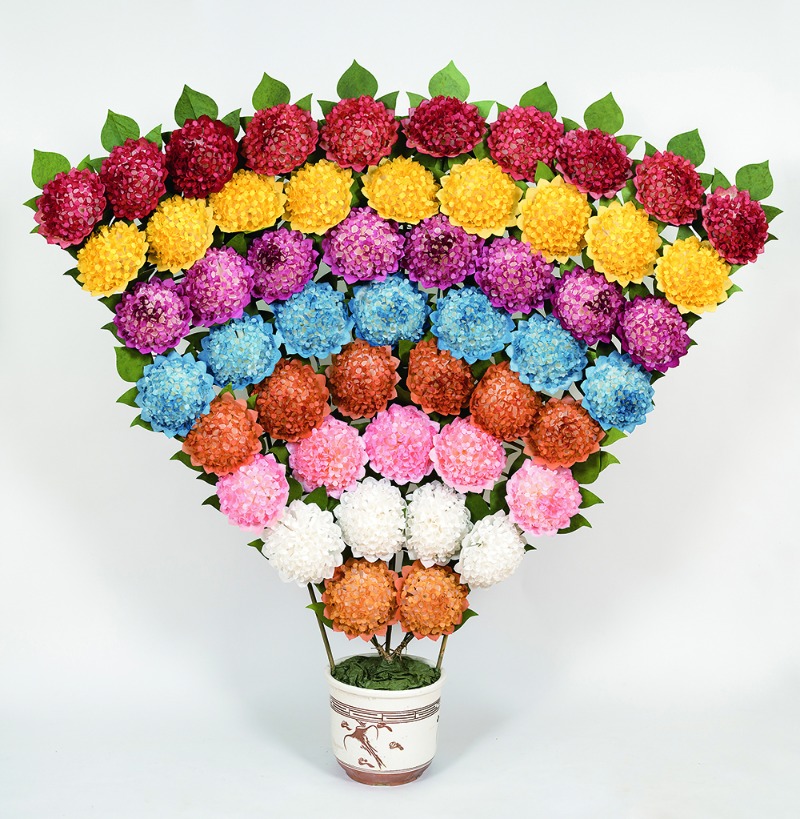
“Fan-shaped Arrangement of Bulduhwa.” 220 ×180 cm.A type of traditional display of paper flowers with the number of flowers progressively increasing upwards. Bulduhwa (literally “Buddha’s head flower”), a species of hydrangea, blooms in trees commonly found on Buddhist temple grounds around Buddha’s Birthday.
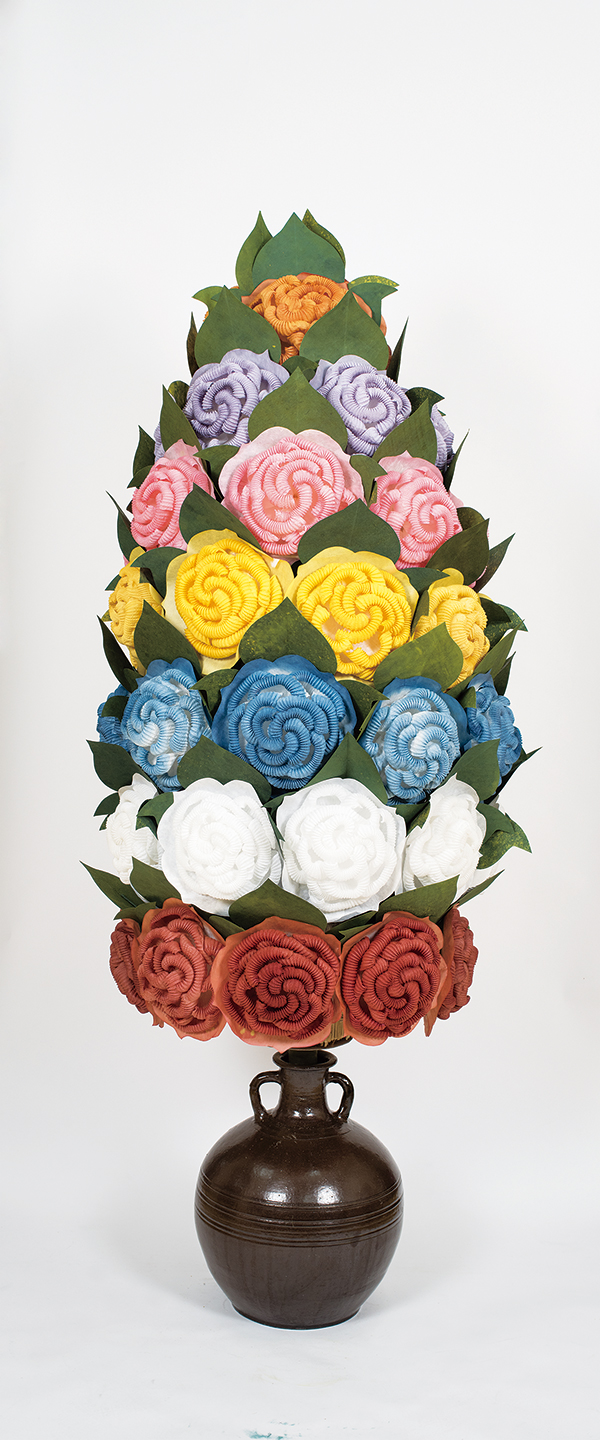
“Cone-shaped Arrangement of Peonies.” 200 × 85 cm.This bouquet of peonies is a recreation of the paper flowers depicted in the Nectar Ritual painting preserved at Yakusenji Temple in Hyogo Prefecture, Japan. Painted in Korea in 1589 during the mid-Joseon era, it is known as the oldest extant painting of the Nectar Ritual.
“In the mid-2000s, when I was serving as chief monk at Gogwang Temple of the Cheontae Order in Copenhagen, I took a trip to Sweden,” he recalled. “In a bookstore there, I came across ‘I * Korea’ [Elanders Boktryckeri Aktiebolag, 1912], written by William Anderson Grebst, a journalist who had visited Korea in the late Joseon period. How glad I felt when I found in the book a photo of peonies made with finely pleated paper.”
Venerable Seokyong has worked to show the traditional craft of paper flowers to the world, holding exhibitions in Denmark, Canada, Japan, Belgium and the United States. In June 2014, when he participated in the Charles County ArtsFest in Maryland, U.S., he ran a booth where locals could try making their own paper flowers, which proved to be very popular. In July 2017, he exhibited more than 30 works at “Korea Art & Soul,” an annual festival sponsored by the Korean American Cultural Arts Foundation. Viewers raved about a magnificent fan-shaped arrangement that stood two meters high and a coneshaped arrangement that included more than 250 flowers.
“At the ArtsFest, President Peter Murphy of the Charles County Board of Commissioners came to me and told me how impressed he was by my work. Then he took his county commissioner badge from his lapel and put it on my robe. All the reporters there were quite surprised,” he said.
Currently, Venerable Seokyong has a workshop in a leased building in Icheon, Gyeonggi Province. Although the minimal conditions for training students have been provided since his craft was officially recognized as provincial cultural heritage, his circumstances as an artisan still leave much to be desired. “I just hope to have a stable place where I can concentrate on my art and many people can come to learn this craft,” he said.
Lee Jung-eunCEO, Cheyul
Ahn Hong-beomPhotographer